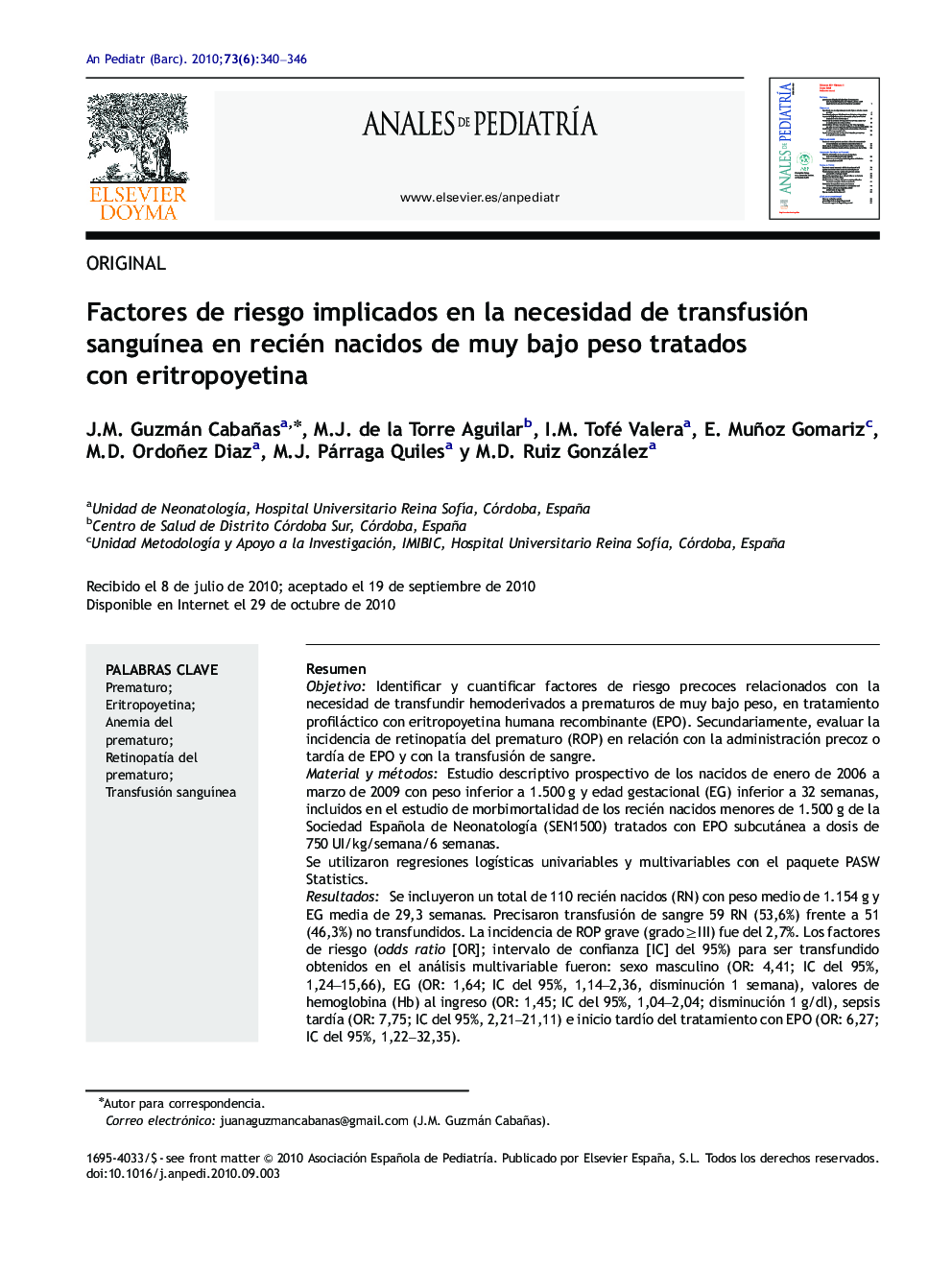| کد مقاله | کد نشریه | سال انتشار | مقاله انگلیسی | نسخه تمام متن |
|---|---|---|---|---|
| 4142501 | 1272376 | 2010 | 7 صفحه PDF | دانلود رایگان |

ResumenObjetivoIdentificar y cuantificar factores de riesgo precoces relacionados con la necesidad de transfundir hemoderivados a prematuros de muy bajo peso, en tratamiento profiláctico con eritropoyetina humana recombinante (EPO). Secundariamente, evaluar la incidencia de retinopatía del prematuro (ROP) en relación con la administración precoz o tardía de EPO y con la transfusión de sangre.Material y métodosEstudio descriptivo prospectivo de los nacidos de enero de 2006 a marzo de 2009 con peso inferior a 1.500 g y edad gestacional (EG) inferior a 32 semanas, incluidos en el estudio de morbimortalidad de los recién nacidos menores de 1.500 g de la Sociedad Española de Neonatología (SEN1500) tratados con EPO subcutánea a dosis de 750 UI/kg/semana/6 semanas.Se utilizaron regresiones logísticas univariables y multivariables con el paquete PASW Statistics.ResultadosSe incluyeron un total de 110 recién nacidos (RN) con peso medio de 1.154 g y EG media de 29,3 semanas. Precisaron transfusión de sangre 59 RN (53,6%) frente a 51 (46,3%) no transfundidos. La incidencia de ROP grave (grado≥III) fue del 2,7%. Los factores de riesgo (odds ratio [OR]; intervalo de confianza [IC] del 95%) para ser transfundido obtenidos en el análisis multivariable fueron: sexo masculino (OR: 4,41; IC del 95%, 1,24–15,66), EG (OR: 1,64; IC del 95%, 1,14–2,36, disminución 1 semana), valores de hemoglobina (Hb) al ingreso (OR: 1,45; IC del 95%, 1,04–2,04; disminución 1 g/dl), sepsis tardía (OR: 7,75; IC del 95%, 2,21–21,11) e inicio tardío del tratamiento con EPO (OR: 6,27; IC del 95%, 1,22–32,35).Todos los RN intervenidos de ductus o enterocolitis necrosante precisaron transfusión. No se ha relacionado la ROP con la administración de EPO precoz o tardía ni con la transfusión sanguínea.ConclusionesLos requerimientos transfusionales son mayores en varones, en prematuros de menor EG, en los de menor Hb al nacer y en los que tienen sepsis tardía. No se ha demostrado relación entre el momento de la administración de EPO con la ROP.
ObjectiveTo identify and quantify risk factors related to red blood cell transfusion in premature babies weighing<1,500 g who received erythropoietin (EPO). Secondly, to assess the relationship between retinopathy of prematurity and rh-EPO.Material and methodsProspective descriptive study of infants admitted to the Reina Sofía University Hospital between January 2006 and March 2009. Infants reviewed had a birth weight<1,500 g and gestational age<32 weeks. Infants were administered rh-EPO 750 IU/kg/week subcutaneously 3 days/week/ 6 weeks.We used univariate and multivariate logistic regressions with PASW Statistics 18 for Windows.ResultsData were obtained from 110 infants, with a mean birth weight of 1154 grs and mean gestational age of 29.3 weeks. Risk factors (OR; 95% CI) for being transfused were: male sex (4.41; 1.24–15.66), GA (1.64; 1.14–2.36, 1 week), Hb level on admission (1.45; 1.04–2.04; 1 g/dl), late onset sepsis (7.75; 2.21–21.11), late onset treatment with rh-EPO (6.27; 1.22–32.35). All surgically treated infants with patent ductus arteriosus ligation or necrotizing enterocolitis needed transfusion. There is no relationship between rh-EPO administration and retinopathy of prematurity (ROP), but there was a relationship with transfusion.ConclusionsPremature infants with the lower gestational age, being male, a lower Hb level on admission and late onset sepsis are those with the greatest risk for blood transfusion.
Journal: Anales de Pediatría - Volume 73, Issue 6, December 2010, Pages 340–346